
Andreana N. Holowatyj, PhD, MS, Details the Main Results of Research into Colorectal Cancer Disparities
The lead author from a study presented at the American Association for Cancer Research Annual Meeting 2021 explained the main findings regarding potential differences in tumor mutation burden by race in patients with early-onset colorectal cancer.
In a conversation with CancerNetwork®, Andreana N. Holowatyj, PhD, MS, of the Vanderbilt University Medical Center, spoke about the main takeaways from her research presented at the American Association for Cancer Research (AACR) Annual Meeting 2021 focusing on tumor mutation burden by race and disparities in early-onset colorectal cancer.
Transcription:
One of the things that we undertook in our analysis was to explore potential differences in tumor mutation burden by race within the population of early-onset colorectal cancer cases. And what we observed in doing so was that compared with young non-Hispanic Whites with a microsatellite stable colorectal tumor, we saw that young non-Hispanic Blacks actually had a significantly higher tumor mutation burden. However, when compared again with [non-Hispanic] Whites, there was no difference in tumor mutation burden with Asian or Pacific Islanders diagnosed with early-onset disease. Seeing this significantly higher tumor mutation burden in young [non-Hispanic] Blacks was quite striking and warranted further study.
Reference:
Holowatyj AN, Wen W, Gibbs T, et al. Advancing Cancer Research Through An International Cancer Registry: AACR Project GENIE Use Cases. Presented at: AACR Annual Meeting 2021. Virtual. Abstract 101.
Newsletter
Stay up to date on recent advances in the multidisciplinary approach to cancer.





















































































